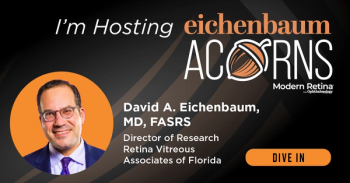
Improving lens feathering during vitrectomy
Lens feathering resulting from intraocular gas can interfere with the visualization needed to perform posterior segment surgery
A recent report1 described an effective technique to improve lens feathering during
The authors, led by Murtaza M. Mandviwala, MD, explained that lens feathering resulting from intraocular gas can interfere with the visualization needed to perform posterior segment surgery. They described how to eliminate this challenge. Mandiwala is from the Department of Ophthalmology, Mayo Clinic, Rochester, MN.
Lens feathering, the investigators explained, may result from either oxidation or desiccation of the posterior lens surface when it comes into contact with intraocular gas, potentially disrupting the epithelial layer’s metabolism and inducing transient subcapsular lens opacities.2,3
They use a light pipe to delicately massage out transient gas-induced posterior lens vacuoles to significantly improve the posterior surgical view during vitrectomy without resorting to a pars plana lensectomy.
After first inserting a light pipe through a cannula into the middle of the vitreous cavity, the surgeon uses the shaft of the light pipe “to gently massage the posterior capsule and flatten and displace the subcapsular vacuoles away from the central axis into the lens periphery,” they described. This process can be repeated in each quadrant as necessary; the infusion line can be temporarily repositioned to another cannula to allow light pipe access through the inferotemporal port.
The authors advised that surgeons performing this technique avoid “inadvertent violation or aggressive manipulation” of the posterior capsule and be certain that only the shaft of the light pipe, and no sharp instruments, touch the posterior capsule.
“It is important to note that this technique is specifically applicable to transient lens feathering induced by air or gas, rather than other types of more chronic posterior subcapsular cataract,” they stated.
This technique developed following the case of a patient who underwent a 23-gauge pars plana vitrectomy and membrane peeling in which 14% C3F8 gas was injected for a fovea-involving combined tractional/rhegmatogenous retinal detachment resulting from proliferative diabetic retinopathy. A fovea-sparing retinal detachment developed about a month later with a significant gas-induced “feathering” cataract. The patient underwent another 23-gauge vitrectomy with retinectomy, silicone oil, and massage of the posterior capsule as described. She also underwent an uncomplicated cataract surgery with intraocular lens implantation in the capsular bag 3 months after the retinal detachment was repaired. One year later, the final best visual acuity was 20/25.
Mandviwala and colleagues also have performed this technique in 2 other cases without complication. They believe this is an effective procedure to improve lens feathering during vitreoretinal surgery without the need for cataract extraction.
They concluded, “This technique allows for improved visualization of the posterior segment, vitreoretinal surgical efficiency, and optimized refractive outcomes for patients who may have accurate intraocular lens calculations and standard phacoemulsification procedures once their retinal status has stabilized.”
References
Mandviwala MM, Adams MK, Barkmeier AJ. The forbidden touch: mechanical clearing of gas-induced crystalline lens feathering during vitrectomy surgery. Int J Retin Vitr. 2024;10:49;
https://doi.org/10.1186/s40942-024-00565-1 Harlan JB Jr., Lee ET, Jensen PS, de Juan E Jr. Effect of humidity on posterior lens opacification during fluid-air exchange. Arch Ophthalmol. 1999;117:802–4.
Matsui E, Matsushima H, Mukai K, Senoo T. Mechanism of gas cataract is mainly related with oxidation. Association for Research in Vision and Ophthalmology meeting abstract, May 2008.
Newsletter
Keep your retina practice on the forefront—subscribe for expert analysis and emerging trends in retinal disease management.












































